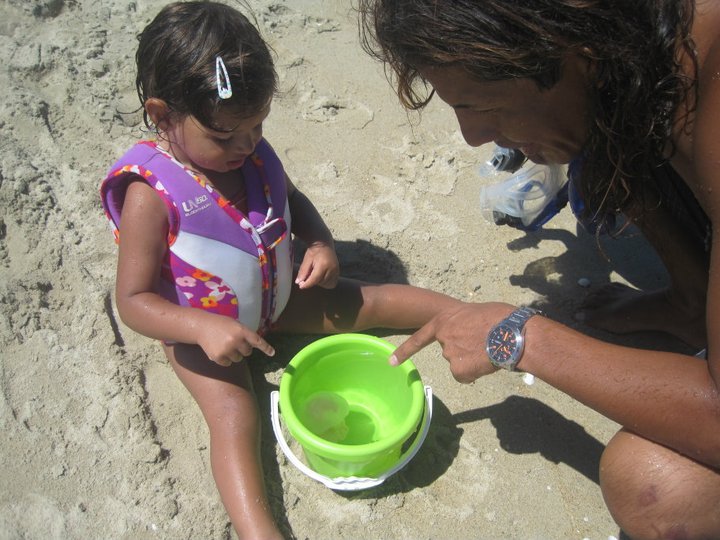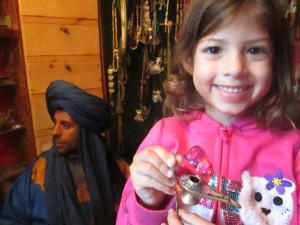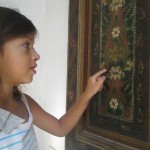
Worldschooling Math
Traveling long-term makes it nearly impossible to carry textbooks, so it becomes necessary to find organic ways to encourage learning subjects like math. However, every day life on the road provides a multitude of natural opportunities to learn math if you take the time to notice and point them out to a child:
1. Number recognition - Point out numbers on signs (especially home addresses as you walk down the street). Discuss price tags. "This means 45. The sign in front tells you it is dollars." Count the number of steps to get somewhere. Have the child count out the number of items needed at the market. Encourage counting in the local language for an added twist. Since visiting Morocco, Tina likes to count out five breads for our breakfast in French. Let the child collect coins (and bills if you can afford the loss) from each country and talk about how much they are worth. This has worked great for getting Tina past the single digits into 10, 20, 25, 50, and 100.
2. Addition and subtraction - While packing, have the child add up how many things they will bring. Then have them take a way some and discover the answer. Anytime a multiple number of items is at hand (e.g., forks and spoons on the table) you can talk about them. "Two forks plus two forks makes four forks. What if we add two spoons? What if we take one fork away?" Works great when you are stuck at a restaurant with bad service.
Overall, addition and subtraction is about more and less. It comes up all the time. Give your child a certain amount of money and let them figure out if they have enough to buy things. "Do you need more money? How much?" Make sure your child gets the right amount of change!
3. Fractions and division - In the context of travel, fractions and division can look like the same thing. Take for example, if you order a pizza and have the child split it up evenly for the family. This could be explained like this: "You have 16 pieces and 4 people who want to eat. That means each person can get 4 slices (division). Or everyone gets 1/4 of the pie (fraction)." Anytime splitting occurs there is an opportunity to discuss fractions and division. "The tour group is splitting in half. That means 10 people will go over there and 10 people will stay in this bus."
4. Multiplication - This is a concept that comes up often if you think about it. Have the child make hotel reservations and calculate the total cost based on rate per night and number of days you will stay. Determine how much money you need for food by calculating costs per day then multiply by 7 or 30 for the week or month.
5. Percentages - You can consider percentage of total cost whenever a discount is offered. In many third world countries, vendors consider their percentage of gain when they start negotiations. In Morocco we noticed a markup of 400% for me (obvious tourist) and only 200% for Edgar (who can pass for a local Berber). We discussed with Tina the reality that prices can fluctuate based on perception and she should consider how much an item is really worth before settling on a price.
6. Algebra - Currency conversion is a wonderful way to help a child grasp algebra concepts. Figuring out how much the local currency is worth in your home currency is a daily task while traveling. For our family, we have to do this twice because I think in US dollars and Edgar thinks in Peruvian soles. We set up mental equations to make quick conversions. "1 US dollar is about 35 Russian rubles. Or 100 Russian rubles is about 3 US dollars, which is about 1 Peruvian sol." Algebra can be essential if you rent a car. Have your child figure out how much gas is needed for a day trip, or how much you'll have to pay to fill the tank before returning the car. (Some of these equations can cross over with multiplication.)
7. Geometry - Notice shapes, point out patterns, discuss the symmetry in a unique piece of art, examine the angles and structural integrity of ancient architecture. Geometry is all around us when we are looking for the opportunity to discover it.
8. Budgeting - What better life skill can you teach a child than to create a budget and stick to it? Let your child know exactly how much money you make and how much it takes to live while you travel. Discuss things like emergency funds, setting aside money for activities like surf lessons or scuba diving, and allowances for souvenirs. Create a spreadsheet and show your child how it works. Then when they ask you for a $50 teddy bear in the Paris De Gaulle airport you can tell them it's not in the budget. Or in my case, I also explained to Tina that I could buy her 5 teddy bears for the same cost if she waited until we got back to the United States. That was a great lesson in impulse control and the value of hard-earned money!
9. Manipulatives - Now what about those kids that need to see things before it clicks? I suggest carrying a small notebook and pencil to write down numbers and equations. You can also take advantage of anything you have in large numbers (e.g., dried fruits, crayons, coins, rocks, Legos) to use them like Cuisenaire (counting) rods.
10. Cartography - Maps are ubiquitous with world travel and they provide a great way to learn lines, points, area, curves, scale, projection, and coordinate systems. Tina likes to collect maps and make her own. We have discussed our location and where we want to go, letting her plot the course and determine the distance traveled. The concept of area is evident when examining the globe. Even a little kid can see that the Earth is mostly covered by water and there are relatively large distances between certain continents. More complex concepts can be gradually introduced as a child's understanding of how to read a map develops.
As you can see, most of these methods to introduce math concepts come up in the day-to-day activities that happen during long-term travel. But they can happen on a short vacation or at home too. It's all a matter of seeing math in every day experiences. Are there any ideas I have missed?

